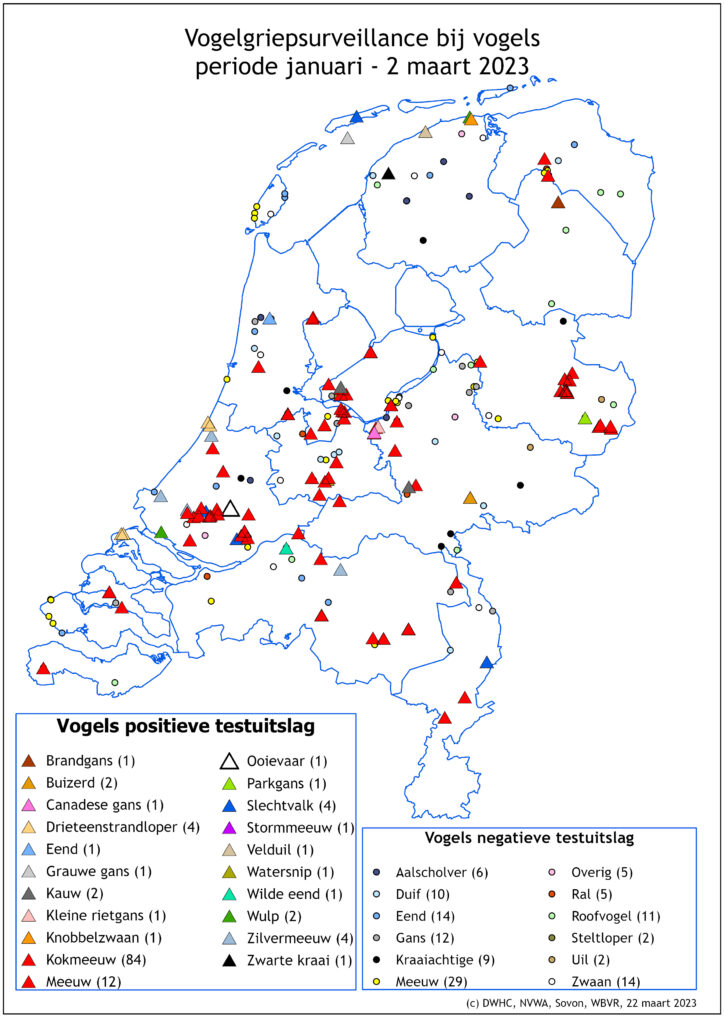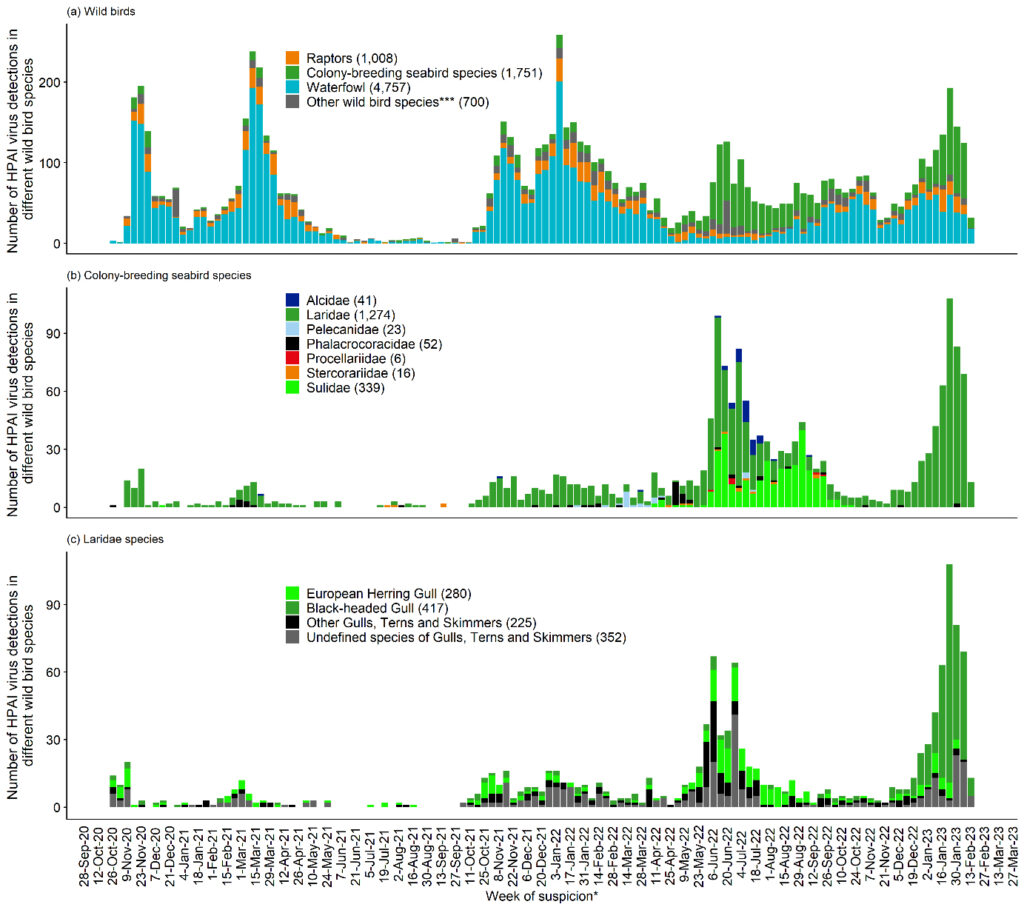Update on mortality in black-headed gulls
By now it is clear that there is an increased mortality in wild birds due to high-pathogenic avian influenza (HPAI), mainly within populations of black-headed gulls. Halfway through February the DWHC and partner organizations published an article about the signs of this trend (https://dwhc.nl/en/keep-a-look-out-for-avian-influenza-in-black-headed-gulls/). The gulls are most vulnerable in roost and breeding colonies, as here there are many birds in close proximity. This creates many opportunities for virus transmission.
Since 15 January, almost 2000 dead gulls, mostly black-headed gulls, have been reported to the DWHC and Sovon. 188 of these gulls have been collected between January 1st and the first half of March, from all over the Netherlands. Of these, 101 gulls were tested positive for HPAI, 29 were negative and 58 are still being examined (see Table 1).
| Species of gull | Positive | Negative | In examination | Total |
| Black-legged Kittiwake | 7 | 1 | 8 | |
| Great Black-backed gull | 1 | |||
| Black-headed gull | 84 | 19 | 34 | 137 |
| Gull, species undetermined | 12 | 2 | 21 | 35 |
| Mew Gull | 1 | 1 | ||
| Herring gull | 4 | 1 | 1 | 6 |
| Total | 101 | 29 | 58 | 188 |
Most of the examined birds were (black-headed) gulls, but other birds were also examined. In table 2, the birds are shown per species group. Map 1 shows the positive birds by birdspecies. It is important to note the four Peregrine falcons and one short-eared owl that have been tested positive for HPAI.
| Type of bird | Positive | Negative | In examination | Total |
|---|---|---|---|---|
| Cormorant | 6 | 1 | 7 | |
| Pigeon | 10 | 10 | ||
| Duck | 1 | 13 | 5 | 19 |
| Goose | 5 | 11 | 3 | 19 |
| Crow | 3 | 9 | 12 | |
| Gull | 101 | 27 | 58 | 186 |
| Stork | 1 | 1 | ||
| Rail | 5 | 2 | 7 | |
| Raptor | 6 | 11 | 2 | 19 |
| Wader | 7 | 2 | 2 | 11 |
| Owl | 1 | 1 | ||
| Swan | 1 | 14 | 15 | |
| Other | 5 | 1 | 6 | |
| Totaal | 126 | 113 | 74 | 313 |

Europe
In other European countries, increased mortality due to avian flu has also been reported. The European Food Safety Authority (EFSA) has published a report on avian flu in the period of December 2022 to February 2023 in which increased mortality was noted among sea birds, mainly gulls and most specifically black-headed gulls.
Increased mortality among black-headed gulls due to HPAI was reported in France, Belgium, the Netherlands and Italy. In Switzerland, increased mortality among gulls was reported, but examination has not been finished yet. In the graph below from the EFSA-report, one can see that mainly colony breeding sea bird species were affected by HPAI (see Graph a). In Graph b, these colony breeding sea bird species are projected per Genus. It can be noted that almost all positive birds are gulls (Laridae). In Graph c, the gulls are projected per species, and most gulls are black-headed gulls. The last bar of Graph c is smaller, but this can be because not all countries have reported their data yet.

Avian flu and humans
Avian flu is a zoonosis: a disease that can be transmitted from animals to humans. Therefore, it is imperative to use the necessary hygienic precautions when handling wildlife cadavers (https://dwhc.nl/en/faq/). On the website of the NVWA (Netherlands Food and Consumer Product Safety Authority), a dutch manual is available for employees of animal ambulances and animal protection for the clearance of wild waterfowl (Handleiding voor het opruimen van dood gevonden wilde (water)vogels | Voorschrift | NVWA).
For information on avian flu in people, and general information on avian flu, we refer to the RIVM, information is in Dutch (https://www.rivm.nl/aviare-influenza).
What to do when finding a dead bird suspected to have died from avian flu?
Reporting for insight in mortality: You can report dead birds on the websites of Sovon (https://www.sovon.nl/tellen/telprojecten/dode-vogel-melden), the DWHC (https://dwhc.nl/meldingsformulier/meldingen-voor-inzicht-in-sterfte/) or waarneming.nl. This way, the scope of mortality among different bird species can be examined.
Removal: If you want the dead bird to be removed , the bird has to be reported to the owner of the location where the bird is found. For more information, please visit: link.
Reporting for examinating the cause of death: If you want a bird to be tested for avian flu, you can report the animal to the DWHC (https://dwhc.nl/meldingsformulier/meldingen-voor-insturen/) or Sovon (https://www.sovon.nl/tellen/telprojecten/dode-vogel-melden), please use ‘insturen’. Because it is impossible to examine all reported birds, a selection must be made. To be selected, the animal must fit the following criteria:
- The animal is intact (head is not missing, the animal has not been driven over, etc.)
- The animal has been dead for at most 24 hours
- Every individual animal has been packaged in 2 plastic bags
- The bags cannot leak, and have to be sealed properly. They cannot be compostable.
- The bird has to be picked up from a postcode-adress
- The bird must be stored in a cool place, but please do not freeze the bird!
Even if the bird fits these criteria, it is not garanteed that the bird can be picked up. Based on the colour of the municipality on the overview map (https://ez.maps.arcgis.com/apps/webappviewer/index.html?id=233f07961dc645dfa795ebe14dce9680), the bird species and the amount of reported birds, the DWHC will decide whether the bird will be selected for examination. The possibilities for examination will be communicated to the reporter by phone or mail. If it is decided that the bird will be picked up, the reporter will receive a code from the DWHC. This code will be written on a label , or on the bag itself.
The birds that will be picked up for montoring for avian flu, will go directly to WBVR in Lelystad for testing. In case of a negative result for avian flu, these birds will not be examined further for the cause of death or other diseases.
Other birds
To report other birds, such as blackbirds, tits, finches etc., the procedure is the same. These birds will go to the DWHC for pathological research. These birds will also be tested for avian flu. We try to pick up birds of prey that have not been frozen for pathological examination. For example, recently two Eurasian sparrowhawks were found to have inflammations in their beaks due to a parasite
Links for information on avian flu
DWHC: https://dwhc.nl/en/ziekten/avian-influenza-bird-flu/
GD: https://www.gdanimalhealth.com/Disease-control/Animal-diseases/Avian-Influenza
NVWA: https://www.nvwa.nl/onderwerpen/vogelgriep-preventie-en-bestrijding
RIVM: https://www.rivm.nl/en
Source EFSA
EFSA (European Food Safety Authority), ECDC (European Centre for Disease Prevention and Control), EURL (European Reference Laboratory for Avian Influenza), Adlhoch C, Fusaro A, Gonzales JL, Kuiken T, Marangon S, Stahl K, Niqueux É, Staubach C, Terregino C, Mirinaviciute G, Aznar I, Broglia A and Baldinelli F, 2023. Scientific report: Avian influenza overview December 2022–March 2023. EFSA Journal 2023;21(3):7917, 43 pp. https://doi.org/10.2903/j.efsa.2023.7917



